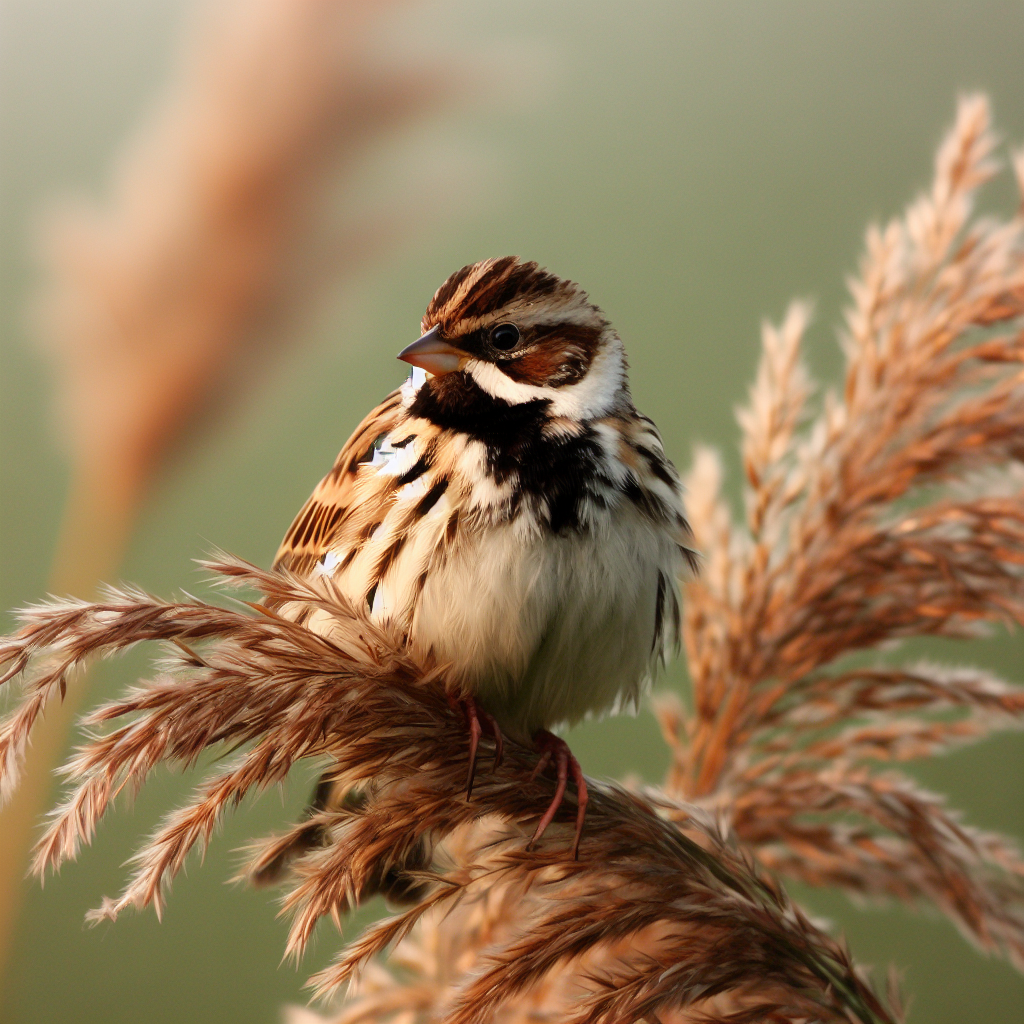Most beautiful small birds - Sykalo Eugen 2024
Common Reed Bunting, Reed Bunting (Emberiza schoeniclus)
Identification:
- Species name: Common Reed Bunting, Reed Bunting
- Scientific name: Emberiza schoeniclus
- Family: Emberizidae (Buntings)
- Order: Passeriformes (Songbirds)
- Subclass: Neornithes (Modern birds)
- Class: Aves (Birds)
Description:
- Size: Small bunting, about 13.5-15.5 cm (5.3-6.1 in) long with a wingspan of 21-23 cm (8.3-9 in).
- Body shape: Slim and agile, with a small, sturdy beak, a notched tail, and a streaked plumage that blends well with vegetation.
- Plumage color:
Males: Black head and throat, contrasting with their white neck collar and streaked brown back and underparts. White outer tail feathers are prominent in flight.
Females: Brownish overall, with less defined black head and throat and more streaking throughout.
Small, sturdy beak, dark brown or black.
Dark brown legs.
Dark brown eyes.
Behavior:
- Method of feeding: Primarily eats seeds and insects, foraging on the ground and in vegetation. May also glean insects from leaves and branches.
- Reproduction: Builds cup-shaped nests on the ground or in low vegetation. Lays 3-5 pale blue eggs with dark speckles. Both parents care for the young.
- Movement: Partially migratory, breeding in Europe and western Asia and wintering in Africa and southern Asia. Some populations may remain resident.
- Communication: Buzzy calls and a simple, melodious song, sung by both males and females.
Ecology:
- Habitat: Wetlands, reedbeds, grasslands, meadows, and farmland with low vegetation. Prefers areas with water or damp ground.
- Diet: Seeds, insects, spiders, worms, snails, and other small invertebrates.
- Hunting methods: Forages on the ground and in vegetation, picking up seeds and insects or gleaning them from leaves and branches. May also hover near flowers to catch insects.
Distribution: Widespread in Europe, Asia, and Africa.

The Common Reed Bunting, a feathered master of disguise in russet brown, might seem like a simple resident of marshes and reeds at first glance. But beneath its unassuming plumage and chirpy calls lies a treasure trove of surprising facts and adaptations that will transform this wetland Houdini into a captivating avian acrobat, hidden feast master, and unexpected winter visitor in your eyes.
Masters of the Reed Maze: Forget clumsy hops; Reed Buntings reign supreme in the domain of swaying reeds and sun-dappled water. Their powerful legs and surprisingly broad wings propel them through the vegetation with breathtaking agility, leaping and fluttering between stalks like feathered trapeze artists on miniature pogo sticks. Imagine them as reed ballet dancers with built-in miniature jetpacks and an innate love for high-wire performances.
Hidden Feasting Technique: Don't underestimate their dietary flexibility! While seeds and insects are a staple, Reed Buntings are opportunistic omnivores, readily adapting their menu to seasonal bounty. From juicy berries and tender shoots to aquatic invertebrates and even the occasional small fish, their varied appetite keeps them fueled for energetic foraging sessions. Think of them as feathered gourmands with built-in miniature buffets hidden within the reed labyrinth.
Singing with Reedy Spirit: Their chirps aren't just simple calls. Reed Buntings possess a rich and distinctive repertoire, with clear, whistling songs, intricate trills, and even a signature "chink-chink" duet call that echoes through the reeds. Their voices rise above the wetlands like feathered oboe players, serenading the sun-dappled water with their reedy spirit and playful partnership.
Unexpected Winter Visitors: They're not just fair-weather residents. Many Reed Buntings undertake surprisingly long migrations, with populations from northern Europe flocking south to warmer regions like the Mediterranean basin. Their efficient energy conservation and ability to find hidden food sources allow them to brave harsh winters, making them feathered explorers with built-in miniature compasses and an unwavering determination.
Champions of Camouflage: They're not always visible targets. Reed Buntings have mastered the art of blending in with their surroundings, their russet brown plumage mimicking the dappled sunlight on reeds and their stillness mirroring the swaying stems. This feathered chameleon, with its built-in miniature cloaking device, becomes almost invisible amidst the vibrant wetland tapestry.
Cultural Charmers: Across Europe and Asia, the Reed Bunting has held diverse cultural significance. In some regions, it's seen as a symbol of resilience and hope, its presence in harsh conditions inspiring admiration. In others, its clever nest-building techniques have led to associations with craftsmanship and skill.
Unexpected Regional Variations: Did you know? Not all Reed Buntings are the same! Different populations across their vast range show subtle variations in plumage color and call patterns, adding a touch of feathered diversity to this adaptable species.